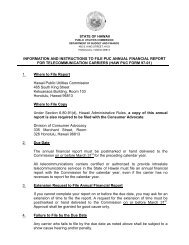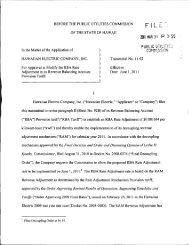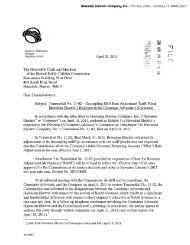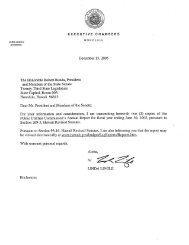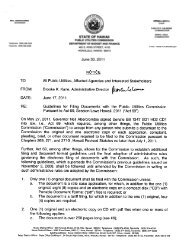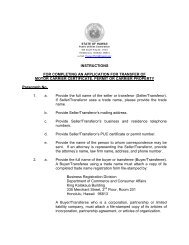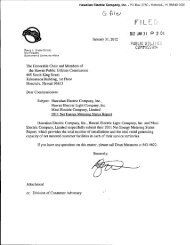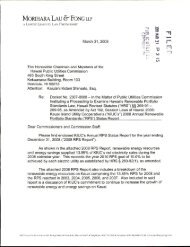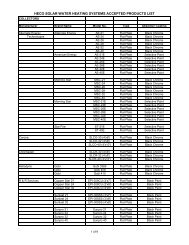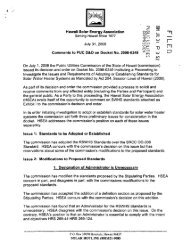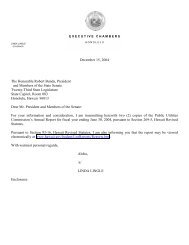PUC Annual ReportâFiscal Year 2011-12 - Public Utilities Commission
PUC Annual ReportâFiscal Year 2011-12 - Public Utilities Commission
PUC Annual ReportâFiscal Year 2011-12 - Public Utilities Commission
You also want an ePaper? Increase the reach of your titles
YUMPU automatically turns print PDFs into web optimized ePapers that Google loves.
<strong>Public</strong> <strong>Utilities</strong> <strong>Commission</strong> <strong>Annual</strong> Report <strong>2011</strong>-<strong>12</strong><br />
State of Hawaii Page 25<br />
Table 6. NEM Status as of December 31, <strong>2011</strong><br />
Utility # of Installations Installed kW<br />
HECO* 3,424 18,518<br />
HELCO* 1,649 10,243<br />
MECO* 1,962 <strong>12</strong>,563<br />
KIUC** 166 784<br />
Total 7,201 42,108<br />
*From the HECO Companies <strong>2011</strong> NEM Status Report<br />
**From the KIUC <strong>2011</strong> <strong>Annual</strong> NEM Program Summary<br />
Energy Efficiency Portfolio Standards<br />
In March 2010, the <strong>Commission</strong> instituted an investigation in Docket<br />
No. 2010-0037 to examine the establishment of energy efficiency portfolio standards<br />
(“EEPS”) for the State of Hawaii, pursuant to Act 155, Session Laws of Hawaii (“SLH”)<br />
2009 (“Act 155”) and HRS § 269-96. Act 155 requires, among other things, that the<br />
<strong>Commission</strong> establish EEPS “designed to achieve four thousand three hundred<br />
Gigawatt hours of electricity use reductions statewide by 2030; provided that the<br />
<strong>Commission</strong> shall establish interim goals for electricity use reduction to be achieved by<br />
2015, 2020, and 2025 and may also adjust the 2030 standard by rule or order to<br />
maximize cost-effective energy-efficiency programs and technologies.”<br />
This docket resulted in a Framework for Energy Efficiency Portfolio Standards,<br />
which establishes EEPS interim goals that will set the course for achieving the 2030<br />
standard set in the HRS. The Framework establishes a Technical Working Group<br />
(“TWG”) that will represent <strong>Commission</strong>-regulated and non-regulated entities in the<br />
EEPS reporting process. On February 17, 20<strong>12</strong> the <strong>Commission</strong> named members of<br />
the EEPS TWG.<br />
<strong>Public</strong> Benefits Fee<br />
HRS Chapter 269, Part VII, pertaining to Hawaii’s <strong>Public</strong> Benefits Fee (“PBF”),<br />
authorizes the <strong>Commission</strong> to contract with a third party administrator (“TPA”) to<br />
implement and manage energy efficiency programs in the State of Hawaii. On<br />
March 3, 2009, following a competitively bid selection process, the <strong>Commission</strong><br />
selected Science Applications International Corporation (“SAIC”) to serve as the TPA of<br />
energy efficiency programs within the HECO Companies’ service territories. SAIC<br />
began administering the Hawaii Energy Efficiency Program (“Hawaii Energy”) on July 1,<br />
2009 and later transferred its program responsibilities to its subsidiary, R.W. Beck.<br />
As part of the PBF implementation process, the <strong>Commission</strong> also selected Bank<br />
of Hawaii as the Fiscal Agent; James Flanagan Associates (“JFA”) as the Contract<br />
Manager; Accuity LLP as the independent auditor; and Economic Consultants Oregon<br />
Ltd., dba ECONorthwest as the independent evaluator of Hawaii Energy’s programs.



